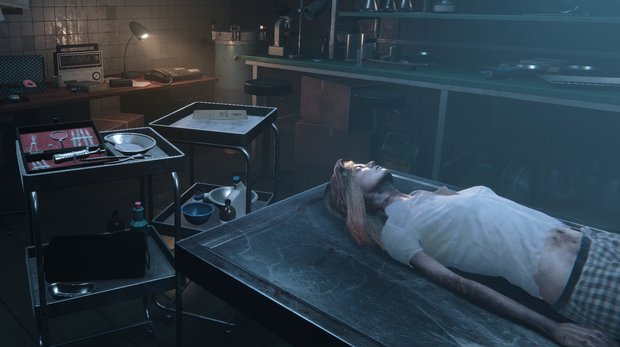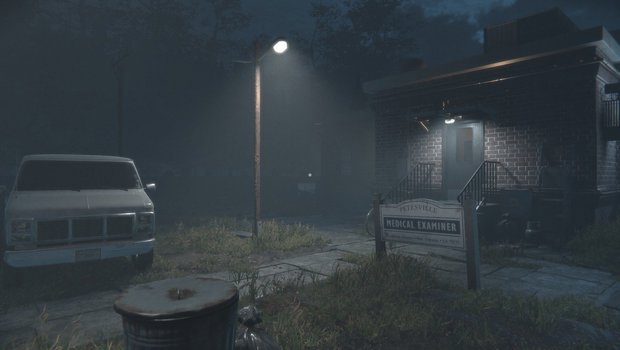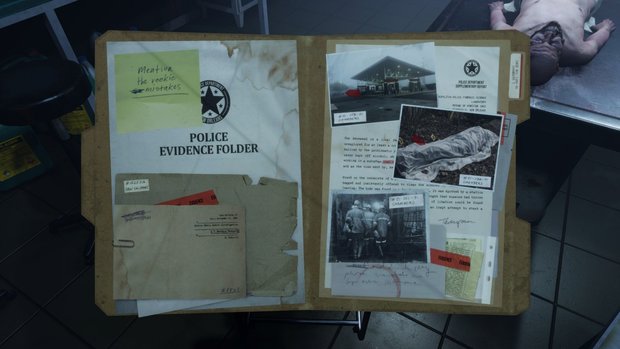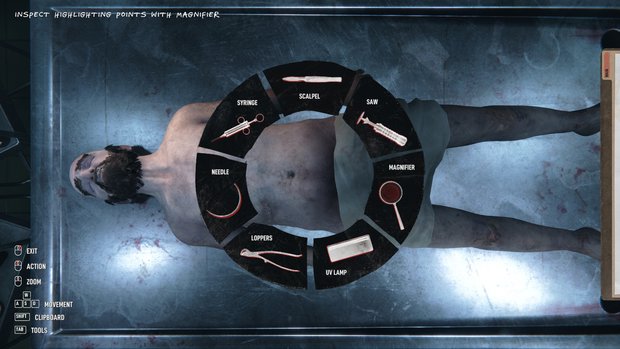Autopsy Simulator review

- 1 Comment
Medically sound procedural displays healthy ambient atmosphere but flatlined player agency and puzzling gameplay experience
Dead men tell no tales. But their coroners might. At least, that’s the idea behind Woodland Games’s spooky first-person workplace-adventure-slash-psychological-creepfest Autopsy Simulator. True, dissecting dead bodies is already far beyond your normal “day at the office,” but throw in a story about personal loss, a protagonist teetering on the edge of sanity, and a haunting environment most of us would be loath to step into even in the most well-lit conditions, and you’ve got a recipe for a nerve-tingling experience, on paper at least. However, not all elements manage to gel perfectly here, resulting in an atmospheric and well-researched effort that will likely just miss the mark for the more seasoned horror buffs out there.
Players don the lab coat and PPE of Doctor Jack Hanman, the county medical examiner in Petesville, just outside New Orleans. Over the course of a handful of nights – Jack only works the night shift – you will conduct several in-depth autopsies to determine each unfortunate soul’s ultimate cause of death. This is where the game puts in the work to earn the “simulator” aspect of its name. While things don’t go so far as to require you to have read your own copy of Grey’s Anatomy ahead of time, the cases and procedures seem academically and medically sound, presented with textbook accuracy while managing to remain very accessible via simple mouse or gamepad movement mini-games. You’ll examine and dissect various organs, perform toxicology tests, take fingerprints and fluid samples, and generally cut, weigh, and suture various squelchy things. From that standpoint, while not over-the-top or reveling in its gory elements, the game will expose you to plenty of graphic content, so those with a highly squeamish disposition, beware!

Autopsy Simulator drives home its gritty realism in another way as well: the deceased you’ll encounter haven’t simply passed due to old age or natural causes. Over the course of five chapters, you’ll deal with corpses that may (or may not) have been victims of foul play, senseless violence, and gruesome and tragic accidents. As a medical professional, you’ll operate on bodies arriving in different conditions, and postulate theories that extend to the darkest areas of what the human psyche is capable of based on the evidence collected. Here, too, the game handles all its subject matter clinically and maturely, without aggrandizing the adult content. While bodies being autopsied must, of course, be unclothed, the developers have included a menu option that can be toggled to blur any areas of nudity (though, like the gore, it’s all presented in a very clinical way anyway).
Playing against typical video game convention, you’ll only be involved in each case from the coroner’s perspective; Jack’s job is to research and analyze, to draw conclusions about the manner of death, and provide those details back to the law enforcement authorities. Once an autopsy has been completed and the body stored for safekeeping, your involvement in the case is at an end – you’ll never know how their stories continue and whether justice ultimately prevails. Instead, the cases act as milestones within the larger, overarching story centered around Hanman himself.

At first you’re not let in on a lot of details, only that something unspeakable happened to Jack’s wife some time ago, and that he’s had a devil of a time coming to grips with it. This plays out within the narrative in a number of ways, the most notable of which is Jack’s frequent need to stop what he’s doing and quite literally pop a chill pill whenever something agitates or unnerves him. And there are plenty of reasons for Jack to become unnerved, from minor (yet spooky) inconveniences like lights in the morgue flickering or the power breakers outright blowing a fuse, to the far more insidious news that a convict with an undisclosed connection to Jack has escaped custody during a routine prisoner transport, and even Hanman’s own home being broken into and ransacked in his absence.
Between these disquieting events happening all around Jack and a job that isolates him from the living, Autopsy Simulator is all about atmosphere. There’s an uneasy feeling of vulnerability that’s palpable as the protagonist is one of only two employees burning the midnight oil at the tiny, run-down medical examiner’s building that appears to be stuck somewhere deep within the Louisiana backwoods bayous. Sure, the surly night watchman Ridley can occasionally be jawed at, but even he seems to have a penchant for randomly disappearing from his post while eerie things are happening in the labs in back.
Players will frequently have to traverse the building’s single hallway as they move between Jack’s office, the examination room, and the crammed storage room in search of pieces of autopsy equipment or to investigate strange noises. Of course, that’s nothing compared to having to head into the basement, only accessible via an exterior cellar door, a task which, like any sane individual, actually made my heart rate spike several times. While the game doesn’t lean heavily into jump scares, it isn’t completely above using them, and the game’s atmosphere benefits as much from its morbid subject matter as from the unsavory, contaminated feeling its environments elicit.
At the same time, there’s an argument to be made that it all feels a little too aimless. It may be realistic that, as the medical examiner, you’re only one cog in the machine of seeking justice for the dead, but being completely cut off from any events preceding or following your examination does feel unsatisfying from a narrative perspective. True, we do get the mystery surrounding the good doctor himself, but it doesn’t really pay off until the game’s very last scene, and even then it’s not all that fulfilling. The moments of tension – noises, visions, general unease – leading up to that are atmospheric to be sure, but they don’t commit enough to please a hardcore horror fan. The benefit of at least one of these aspects being more fully honed to a cutting edge would doubtlessly have done wonders for the overall payoff.

The game’s production values suffer from the same “win some, lose some” syndrome. True, the Petesville medical examiner’s offices aren’t supposed to look nice, bright, and cheerful – that’s kind of the point. It’s also true that corpses with tissue damage or in various states of decay aren’t meant to win any beauty contests. But even so, the presentation leaves something to be desired. Don’t get me wrong – the environments are generally good, and well detailed to boot, but it’s plain to see where corners were cut. Animation is in short supply and is often avoided outright by rarely having any actual (living) character models on-screen. Bathroom mirrors are too cracked to show reflections, Ridley is usually hidden behind a newspaper, and all other characters simply appear as disembodied voices out of a headset or answering machine speaker. As for the bodies Jack must work on, well, they’re pretty hideous to behold, and not just for the obvious reasons.
Autopsy Simulator eschews a musical score, preferring to maintain its realistic workplace ambience instead through sound effects and voiced dialogue. In fact, there’s rarely a moment when Jack isn’t busy talking and narrating. While it’s certainly a nice touch to have such an abundance of voiced commentary, our main character’s tendency to overdramatize does become a little trying before long. Even before events pile up and threaten to destabilize his inner balance, he is extremely prone to whining and sneering, moaning and groaning in discontent during practically every other line, making it difficult to fully get behind him. However, apart from his internal monologues, autopsy recordings, phone conversations, and plain old frantic outbursts when something spooks him, Hanman also talks us through all of his scientific findings, oftentimes turning medical jargon into easily understandable speech.
Looking back at the game as a whole, there is one final criticism I think deserves pointing out, and it’s a big one. After completing the very first autopsy, I felt like I had been taken by the hand and guided step by step through each part of the process, from sifting through the crime scene data supplied by the police to getting some quick primers on the surgical tools available to me. That’s understandable, I thought, seeing as how the first case had to act as a tutorial of sorts. I’m sure the next one will give me a bit more freedom. Not so. No matter whether a procedure introduces a brand new step or is one you’ve performed several times before, Jack will cue you through every step of it, including reminders for even the simplest of steps, like donning your plastic gloves and apron at the start of every single case.
I wanted to be able to actually perform an autopsy, but instead each chapter consists of a carefully laid-out checklist that must be followed to a tee, and Jack will be there to talk you through each and every step along the way. This also means there’s no room for puzzles that need solving; you might think autopsies themselves are the ultimate puzzle, but here they are presented as by-the-numbers and procedural as possible, and the gameplay experience is the poorer for it. The closest we get to having to solve a puzzle is to occasionally search the premises for missing pieces of equipment in order to perform the next step of the current procedure.
Final Verdict
Autopsy Simulator puts effort into delivering exactly what it says on the label, and in doing so it presents several well-researched postmortems that appear medically sound and provide an interesting time. It also tries to go one better by weaving a psychological thriller about the doctor performing said autopsies, which doesn’t come off completely without a hitch but still leads to some creepy goodness. But it’s in the gamification of the whole kit and kaboodle that missteps are taken, eliminating engaging puzzle gameplay in favor of leading players down a straight and narrow path with no room for deviation or experimentation. This undercuts the sense of satisfaction the game as a whole provides, and what’s left is the warm body of a good idea that already has a certain cold stiffness beginning to settle in.
Hot take
Autopsy Simulator’s puzzle elements may be dead on arrival, but the well-researched autopsy cases presented in the unsettling atmosphere of an isolated coroner’s office injects enough thrills to give the game some measurable signs of life.
Pros
- Dingy and isolated atmosphere makes the isolation palpable
- Autopsy cases feel realistic and pulled straight from the headlines
- Medical jargon and procedures made very player-friendly
Cons
- Puzzles? What puzzles?
- Campaign guides you by the hand and never lets go
- Protagonist’s put-upon nature becomes hard to swallow
Pascal played Autopsy Simulator on PC using a review code provided by the game's publisher.











1 Comment
Want to join the discussion? Leave a comment as guest, sign in or register in our forums.
Indeed, I've heard the same critique of too much handholding, and that it's far too linear and lacking in freedom to earn that title "simulator". But the rest doesn't sound too bad.
Reply
Leave a comment